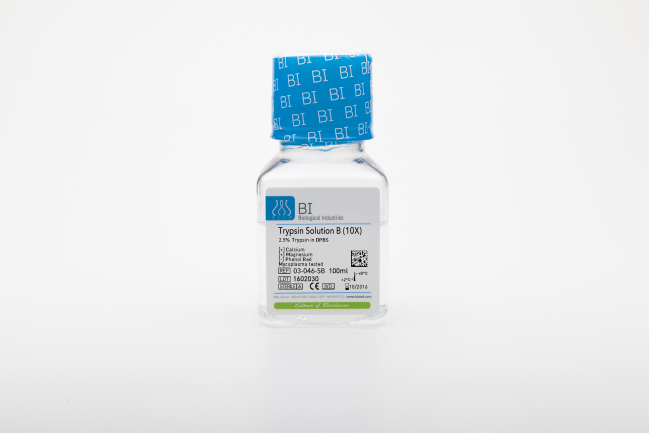
价格:350
货号:03-046-5B
规格:100ml
产品名称:Trypsin Solution B (2.5%), 10X Conc., without Calcium
and Magnesium, without Phenol Red
胰蛋白酶(不含钙和镁,不含酚红,10倍浓缩液)
【产品介绍】
Trypsin, an animal-derived product, is the most commonly used enzyme for harvesting cells in
culture. Trypsin is a pancreatic serine protease (proteolytic) enzyme with specificity for peptide
bonds involving the carboxyl group of the basic amino acids, Arginine and Lysine. Trypsin often
contains a crude mixture of lipases, nucleases, polysaccharides and proteases extracted from
Porcine pancreas.
Most cell cultures grow as a single thickness cell layer or sheet attached to a substrate known
as a monolayer. When subculturing adherent cells, these intercellular and cell-to-substrate
links or connections must be gently dissociated. Proteolytic enzymes such as Trypsin (i.e. a serine
peptidase), breaks or gently separates these bonds by creating a single-cell suspension from
which new subcultures are realized. Trypsin solutions are widely utilized as cell dissociation
reagents for continuous cell culture of adherent growing cells. Trypsin proteolysis or trypsinization
is a process in which proteins have been digested or treated with Trypsin and are thus said to
be trypsinized. Biological Industries' Trypsin is designed not only to gently dissociate cells from
almost any support substrates but also as well as from each other in order to actualize cell
manipulation techniques in addition for other studies that require intact cell-surface proteins.
Trypsin, as a solution, is available in a varied array of ormulations with or without EDTA. EDTA
is a chelator that binds calcium and magnesium ions that may otherwise inhibit the Trypsin activity
which then hydrolyzes and gains access to the intercellular bonds being cell-cell and/or cell-substrate
bonds. Crude Trypsin is often the subculturing agent of choice for cell dissociation/disaggregation
of adherent cells although the treatment may be cytotoxic if prolonged. Over-trypsinization is
a common cause of subculture problems.
The use of Crude Trypsin often involves multiple changes and the variability among lots can
dramatically influence the effectiveness of the dissociation process. Regarding the use of Crude
Trypsin, some important facts must be noted:
v Cells must NEVER remain in the Crude Trypsin for longer than 3-5 minutes as they may be
seriously damaged in the process (i.e. damage to the intracellular proteins).
v Cells should NEVER be left without a fluid layer
v Do not permit prolonged growth on culture ware as the cells will be very difficult to
remove(i.e. after5-7 days)
In a serum-free culture environment, the cells must be separated by rapid centrifugation or by
utilizing Trypsin inhibitors such as Soybean Trypsin Inhibitor (SBTI). SBTI is a single polypeptide
that forms a stable, stoichiometric, enzymically inactive complex with Trypsin thereby reducing
the availability of Trypsin by, more or less, binding chymotrypsin. However, with Biological
Industries' Soybean Trypsin Inhibitor, any excess Crystalline Trypsin may be completely neutralized,
thereby avoiding the use of serum for this purpose. The cells may then be resuspended successfully
in a suitable growth medium.
Predominant Characteristics of Trypsin Solution B (0.25% in DPBS) without Calcium & Magnesium,
without Phenol Red include:
§ Animal-Derived Source
§ Meets USP and EPTesting Specifications
§ Cell-Culture-Tested
§ Suitable for Cell-Culture Applications
§ Long-Storage When Handled Properly Under Defined Conditions
说明书下载:
 6381101566233924104044976.pdf
6381101566233924104044976.pdf